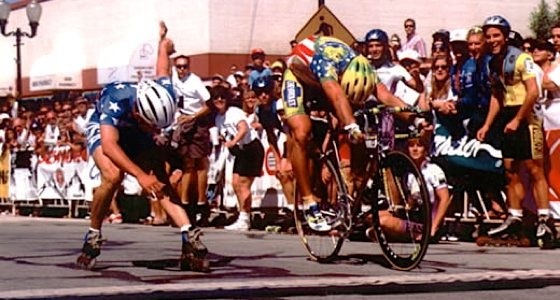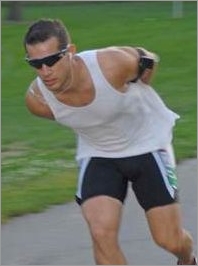 | ||
| ||||||||
By a Wheel - Tony Muse is edged out in the skate vs cyle challenge at the Downers Grove Criterium (circa 1995). Winning the race was Olympic gold medalist Steve Hegg. By Tony Muse Tony Muse talks about the Downers Grove cycle vs skate challenge: "I was fortunate enough to be chosen five times to represent our sport. I won twice and was the only skater who ever did. This picture (above) was from the first race I lost to Steve Hegg, who was an Olympic gold medalist and a great guy as well. As you can see, I lost by a few inches and this was before any of us had really learned to perfect the eagle hawk. If only I knew then ... !" People sometimes ask me what it's like to be the little brother of one of the greatest skaters in the history of inline speed skating? I tell them I feel very blessed. My brother Dante is renowned for his endurance, his ability to throw a pass on a dime, his cat-like balance, and his uncanny ability to simply win. I lived in the shadow of his huge talent as I was growing up. And at times, I hated it. But in hindsight, I see that it was a blessing because it forced me to find my own way to the top. I, too, wanted to win and aspired to greatness. I couldn’t outlast Dante, or out-tactic him — or even out-crazy him, so I made it my goal to be flat-out fast. It worked. I eventually accumulated my own collection of world titles and set a sprint world record. These days, I still love speed. In my pursuit of it, there are three things I keep in mind every time it's time to go fast. 1) Butt down This may seem obvious, but it's by far the hardest thing to do when it counts the most. Most of us think that moving our feet fast equates to high speed — and to spectators, we do look fast when our feet are flying. But in fact, something else often happens when we take quicker steps — we tend to rise up out of our low skating position — and this can cancel out any benefit we get from faster foot speed. Another thing that gets us out of the low skating position is fatigue. When we are tired, our natural inclination is to stand up and take the load off our legs. But when we do, we shorten our stride, which takes the power out of our push. Another thing we tend to do when tired is to drop our heads. And guess what? As the head sinks, the butt rises. So what's the answer? Literally, you should continually remind yourself to keep your butt down. Should you move your feet faster? Yes, of course. But at the same time, remain in the low skating position. No matter how tired you get, keep your butt down! Consider what Eric Heiden used to do as he prepared for the Olympics: low walking for a time period equal to each of his events. (Related skate tip with instructions for low walks: Get Down for More Speed) What's so great about that? Try it yourself for just minutes … and don’t forget to keep your butt down! 2) Drive your knees to your chest.
When you start going fast, a couple of things happen. Your feet start to push farther to the side and, as a result, they start to get behind you. This makes it harder to get your legs back all the way under your body, which is where your push has the most power. To fix this, drive your knees to your chest as you land your skates under your body. Your goal is the finish line, driving your knee forward will aim your momentum in the right direction. 3) Swing your arms hard across. This is simple. "Swing your arms and your legs will follow." But it gets a little more complicated if you are a double-pusher. Many of the world's top sprinters still get it done the old-fashioned way with classic technique. And lots of skaters use the double-push when they are cruising and switch to classic stride when it's time to go. But skaters who use double-push when sprinting need to make a subtle adjustment to their arm swing. When sprinting, you should always swing your arms hard and finish across. But if you are double-pushing, there is a little kink in the arm swing that involves a subtle forward start, which coincides with the first of your two pushes (the under push). As you power your arms across your chest, they will force your legs to push more into the "power box" area, directly beneath you, rather than to the side or back. (Related skate tip: Go Faster With Arm Swing) Making It Stick These are the three keys of skate technique that my coach (and brother) Mark Muse constantly reminds me about and that I work on every time I skate. I also rehearse these techniques mentally when I'm preparing to skate. Of course, all skaters are different and must find their own path to their personal best. But you can count on these techniques to provide a powerful foundation for your future success. But getting back to Dante, he, as my older brother, was always expected to beat me. So when I did manage to win, he was bitter, which made it two wins in one. ---
Related reading: • Skate Tip of the Week Archive comments powered by Disqus
...
Copyright © 2007 Inline Planet | ||||||||


